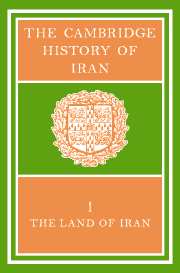13 - GEOGRAPHY OF SETTLEMENT
from PART 2 - THE PEOPLE
Published online by Cambridge University Press: 28 March 2008
Summary
GENERAL CONDITIONS OF SETTLEMENTo
The habitats of nomadic and settled peoples; natural environmentand present-day distribution
The life of Iran is dominated above all by the disparity between the nomadic peoples and those who are settled—between the shifting habitat of the former and the permanent homes of the latter. The ecological conditions responsible for this division are, broadly speaking, well-known, and a reasonably accurate delimitation has been possible, especially of those regions where the rainfall permits regular cultivation and permanent settlement. These areas include the mountain chains of the Caspian and of Khurāsān (south of the river Atrak); a large part of Äzarbāljān (with the exception of the basins of the river Aras and Lake Rezā'īyeh); and virtually the whole of the Zagros mountains north-west of Shirāz. Fārs is made up partly of cultivable mountain slopes and partly of basins too arid for agriculture. Scattered areas of rain-cultivation also exist in the south-eastern parts of the Zagros, in the mountains of central Iran north of Yazd and Kirmān, and in Kūhistān, over to the east of the country and north of Bīrjand.
Much less is known, however, of the distribution and the itineraries of the great nomadic groups. One still has to rely above all on the data gathered together in Field's massive compilation—a useful work even though its geographical information is far from complete. Nevertheless, a study of the facts relating to the two ways of life does lead one to some remarkable conclusions. Though, understandably, there are but few nomads in the humid, cultivable areas in the north of the country and in the mountains of Āzarbāījān, and though their importance predictably increases when one comes to the arid regions of Balūchistān, they are nevertheless few in number in the great deserts of east-central Iran; while the huge nomadic confederations of the Qashghai, the Bakhtīārī, and the Khamseh dominate the Zagros mountains, where climate might have been expected to favour cultivation and a settled way of life.
Keywords
- Type
- Chapter
- Information
- The Cambridge History of Iran , pp. 409 - 467Publisher: Cambridge University PressPrint publication year: 1968
References
- 5
- Cited by

